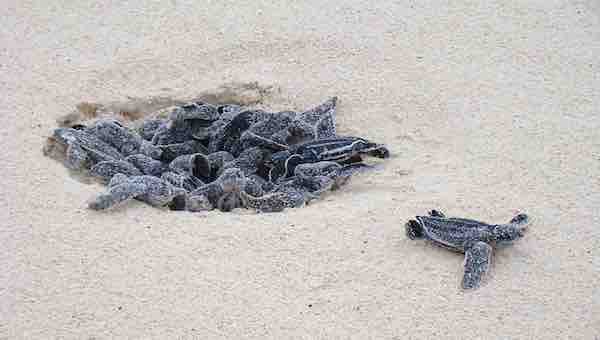
FILE PHOTO BY ELISA PETERSON, CC LICENSE
PALM BEACH COUNTY SMASHES ALL-TIME RECORD FOR SEA TURTLE NESTS: 21,800 & COUNTING
BY: ANDY CORBLEYORIGINAL SITE: THE GOOD NEWS NETWORK
TOPICS
Activism
AI
Belief
Big Pharma
Conspiracy
Cult
Culture
Deep State
Economy
Education
Entertainment
Environment
Faith
Global
Government
Health
Hi Tech
Leadership
Politics
Prophecy
Science
Security
Social Climate
Universe
War
Palm Beach County has already shattered the record for the number of turtle nests recorded during a single nesting season on Juno Beach, with three months of counting still to come.
By Sunday, the 9.5-mile Juno Beach in the northern part of the county had seen 21,872 mostly-loggerhead sea turtle nests, compared to an end-season total of 18,132 nests last October.
“We are so excited to break this all-time nesting record and can’t wait to see if each sea turtle species breaks its individual record,” Dr. Justin Perrault, vice president of research at Loggerhead Marinelife Center, said in the news release .
The overwhelming majority, around 15,000 of the nests, belong to the loggerhead species, but green and leatherback sea turtles also nest there. All of these species are considered vulnerable or endangered.
“Ocean conservation efforts that have been practiced for decades are finally coming to fruition, and we need to make sure that we continue to protect these animals and their ecosystems,” he said.
The counting was done by the Center on Juno Beach, Jupiter-Carlin Park, and Tequesta.
MORE REPTILE CONSERVATION: Baby Galápagos Pink Iguanas Seen for the First Time Ever—Offering So Much Hope to Scientists
Joyously, it’s not only Florida that is having a bumper crop of turtles.
On the beaches of Baldwin County in Alabama, experts believe they are on pace for a banner year. Unlike Florida, the end of August heralds the end of the nesting season, and the 13 nests of loggerhead, Kemp’s ridley, and green sea turtles are already 2 more nests than the whole of the 2016 and 2017 nesting seasons.
MORE TURTLE NEWS: After 10 Year Absence, World’s Most Endangered Sea Turtle Nests on Texas Beach, With a Little Help From Friends
“Those were our benchmarks and being ahead of that already at this point, it’s very exciting,” said the program director for Share the Beach, a volunteer organization that stakes and marks out turtle nests.
In recent years, some US Gulf Coast and Atlantic states have seen record increases in turtle nests, projecting an image of the United States as a turtle sanctuary since any turtle that hatches there will return year after year to lay their eggs on the same beach they were born on.
